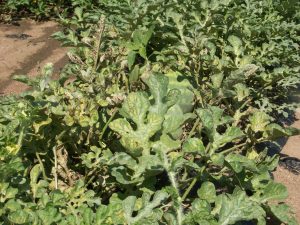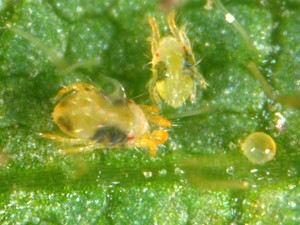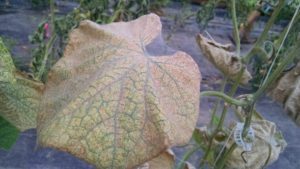Despite the wet start to the summer that we are experiencing, we have some growers reporting spider mites in field watermelons (Figure 1). This pest is typically associated with hot, dry weather and can be especially problematic in crops grown under protection, such as in high tunnels. Spider mites often move into a field from an adjacent fencerow or rye strip.

Figure 1. Spider mite damage can be recognized by the inter-veinal chlorosis on the leaves, such as on these watermelon plants.
Two-spotted spider mites (Figure 2.) are most commonly a problem on watermelon and cucumbers in high tunnels, but also affect muskmelons. They can be detected by observing the yellowish discoloration on the upper side of the leaves or using a 10x hand lens and scouting on the underside of the leaf for the pest. Alternatively, you may use a white sheet of paper and tap the leaves above the paper to dislodge the mites; you will see them moving about on the sheet of paper.
Because mites often migrate into a field from adjacent habitat, begin scouting on field margins. Dust on plants, from an adjacent gravel road, also provide a thriving habitat for this pest, so scout these areas. Mite populations are often localized within a field, so targeted treatment of the infested area and 100 feet around the outbreak should contain the mites and decrease the costs of treatment. While there is currently no threshold for mite populations, stressed plants can tolerate far fewer mites than healthy plants.
In hot, dry weather mite populations can increase rapidly, up to 70X in a week! Heavy infestations result in a thick webbing appearing on the plant (Figure 3). Therefore, scouting should be done often. Crops that are not irrigated tend to be more susceptible because the nutrients are concentrated in the leaves and the mites can increase more quickly, adding to the already water-stressed damage in the plant. Mite feeding can lead to defoliation in as little as a week or can result in direct damage to the fruit, lowering yield. Mites can feed directly on the fruits themselves, and result in a sandpaper-like texture to the rind.
There are a number of miticides labeled for cucurbit production and listed in the Midwest Vegetable Production Guide for Commercial Growers (ID-56) https://ag.purdue.edu/btny/midwest-vegetable-guide/Pages/default.aspx. Agri-Mek® has consistently provided good to excellent control and is a good choice if you have a serious infestation. We have seen good control on cucumbers using Portal®. We have also seen excellent results with one of the newer reduced-risk miticides, Oberon®. For high tunnel applications, be sure to check the label for use in greenhouses; if the label prohibits use in greenhouses it may not be used in high tunnels.

